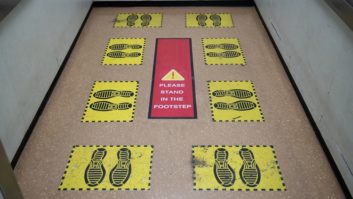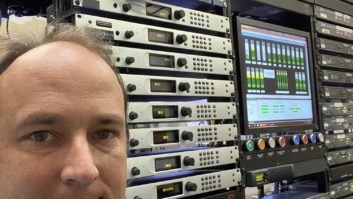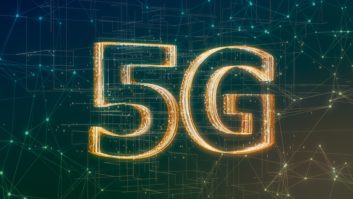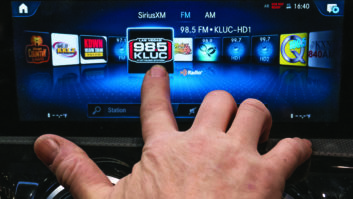NEW SERVICE IS ‘LAST IN’
I’m happy that you have started to address this in Radio World (“Is There a 4G Problem?” RW Engineering Extra, Oct. 15).
My first experience was in Florida, with our antenna above and on the same tower with AT&T. They noted cabinet radiation. Our transmitter was an old Energy-Onix that did exhibit severe cabinet radiation. Prior to that, I had read on the BDRnet of others experiencing similar complaints, so I had an idea of what to expect.
I was able to see the 12th harmonic outside the building, using a consumer grade, uncalibrated, log periodic antenna. I traced it down to some meter openings and spaces in the front panels. Fortunately, we had just discovered a supply of fine mesh copper screen at another site and we built a skirt, attached to the output flange and draped over the transmitter, which effectively shielded the harmonic cabinet radiation. Since then, I have received a handful of complaints at other sites. Usually they come by way of a phone call from the local technician who has been hired by the phone company to search for interference. My experience is that they have been given an antenna and told to look for anything above a certain level, typically somewhere around –120 dBm.
When pressed for a reference or actual procedures, they have generally gone away.
I did have one case where it was the second harmonic of an STL system that was showing up in the 900 MHz band. The AT&T tech had his 12-element Yagi touching the front panel of the transmitter and noted interference. I told him that you could probably see interference from a power supply with that methodology and contested his methods. He went away.
My basic position is that 4G constitutes a new service and therefore, they’re the last one in, even if the company (ATT, Verizon) has been there for years.
Jeffrey Zimmer
Family Stations Inc.
Oakland, Calif.
HARMFUL INTERFERENCE
I am writing to explain some of the issues mentioned in Michael LeClair’s article.
All users of the radio spectrum need to keep their out-of-band emissions below the threshold of harm. Refer to FCC Rules:
§2.1 Terms and definitions.
Harmful Interference. Interference which endangers the functioning of a radionavigation service or of other safety services or seriously degrades, obstructs, or repeatedly interrupts a radiocommunication service operating in accordance with [the ITU] Radio Regulations. (CS)
Interference. The effect of unwanted energy due to one or a combination of emissions, radiations or inductions upon reception in a radiocommunication system, manifested by any performance degradation, misinterpretation or loss of information which could be extracted in the absence of such unwanted energy. (RR)
No matter what, any radio transmitter may not cause Harmful Interference.
Secondly:
§73.317 FM transmission system requirements.
(a) FM broadcast stations employing transmitters authorized after Jan. 1, 1960, must maintain the bandwidth occupied by their emissions in accordance with the specification detailed below. FM broadcast stations employing transmitters installed or type accepted before Jan. 1, 1960, must achieve the highest degree of compliance with these specifications practicable with their existing equipment. In either case, should harmful interference to other authorized stations occur, the licensee shall correct the problem promptly or cease operation.
(b) Any emission appearing on a frequency removed from the carrier by between 120 kHz and 240 kHz inclusive must be attenuated at least 25 dB below the level of the unmodulated carrier. Compliance with this requirement will be deemed to show the occupied bandwidth to be 240 kHz or less.
(c) Any emission appearing on a frequency removed from the carrier by more than 240 kHz and up to and including 600 kHz must be attenuated at least 35 dB below the level of the unmodulated carrier.
(d) Any emission appearing on a frequency removed from the carrier by more than 600 kHz must be attenuated at least 43 + 10 Log10 (Power, in watts) dB below the level of the unmodulated carrier, or 80 dB, whichever is the lesser attenuation.
In the case of Harmful Interference the minimum attenuation required in §73.317 (d) can be changed. The words “at least” clearly indicates that there is plenty of margin that can be added. And §73.317 (a) clearly states that “licensee shall correct the problem promptly or cease operation.”
The issue at hand, from what I have heard, is cabinet radiation. This may be new to some people, but it is something that I’ve been through before. The interference isn’t in the transmission line or coming out of the antenna. It is radiating from the transmitter itself.
Many years ago KGEI, a shortwave broadcast station, changed to a new frequency and immediately got complaints from the FAA. A high-order harmonic of their HF transmit frequency happened to be exactly on the frequency of San Francisco Approach Control. They could not find any sign of the harmonic in their transmission line, but after a couple of nights of making field measurements I could readily detect the harmonic and was able to DF it to the transmitter building and not the antenna.
Even though it was barely detectable it was loud enough to cause Harmful Interference with San Francisco Approach Control. Not a good thing.
This issue is not limited to 700 and 800 MHz 3G/4G carriers. I know of one instance where an FM station cabinet radiation wiped out a Public Safety 800 MHz control channel. One of their trunked simulcast sites was collocated with an FM station. Turning off the transmitter eliminated the interference, proving that it was coming from the station, but not from the antenna.
When receivers operate at the thermal noise limit, which is easily done with today’s technology, it does not take much energy to cause Harmful Interference.
However, one must also keep the reports honest. I also have found that unsophisticated users just crank up the gain on their spectrum analyzers and generate harmonics in the instrument with out-of-band carriers.
Yes, they can see something at 1.8 GHz, but it may be generated in their instrument. Also it is possible that tower top amplifiers can generate harmonics because they don’t have enough pre-selector attenuation to keep out-of-band carriers from driving the amplifier into distortion.
Should you find yourself in this situation, it is critical that you don’t blow the complaint off, but also critical that good engineering measurement practice be followed to find the source. Few really know how to make accurate radio frequency measurements.
Bill Ruck
Broadcast Engineer
San Francisco
FAMILIAR ISSUES
We have had the same issues [with 4G] here in the Twin Falls, Idaho market. We have a butte that is used by every radio service, radio stations and television stations, not to mention the cell phone industry.
Two things have changed the landscape when it comes to interference: 1) higher gain antennas, and more of them; 2) increased sensitivity of the cell site receivers.
In a recent situation, AT&T was the company that was receiving interference. One case involved the station I work for, which is commercial, the other our neighboring noncommercial.
Both stations easily met the FCC harmonic rules, as measured by an independent engineer. A second P.E. verified this result.
In my case, I have two transmitters that are combined into one antenna. This is a three cavity per transmitter system by ERI. Both transmitters are BE FM-30T. In my case, 98.3’s 19th harmonic was wiping out one of the AT&T blocks.
In this case, it was found that this harmonic was coming from the cabinet and not from the antenna. It was also found that AT&T had a 18 dBi antenna pointed right at the transmitter, with only about a 300-yard separation, coupled to a –130 dB receiver.
Since the facility had a good ground system already, there was no room for improvement there.
The first step was to install filters. There was one put into the exciter, and a quarter-wave cavity between the exciter and IPA (doing anything between the IPA and final was out of the question due to the transmitter design).
The next step was to ground the cabinet doors with 4-inch copper strap, then put screen over the air filter vents. One would conclude that this would be more than enough to curb a harmonic that far removed. It wasn’t.
The final fix was to excessively load the PA and retune it watching a spectrum analyzer. This was hard to do since the noise floor was barking at about –107, but it was done to everyone’s satisfaction.
I was not a part of the noncom’s project, but they are on a shared tower with the main television station here, and run a large vertical array. They are literally above the AT&T antenna system. Whatever process they did managed a cure.
This situation took months to cure, and created some ill will amongst all the parties concerned (not to mention the various costs).
As a sidebar, I had this same transmitter go down not too long ago. For all intents and purposes, it looked like a failure of the PA tube. Pulling the old tube revealed that it was completely cooked (the anode was black). A new tube, however, did not bring the transmitter back to life.
All of the voltages were present, all circuits were functioning. I took apart the entire PA trying to find out why it refused to work. In doing so, I found that the screw attaching the N connector center pin to the input matching circuit was gone. There was no screw inside the PA grid cavity. It was gone.
In the process of the self-destruct, the fuse link was the reason it refused to work. However, since this fuse link is hidden from “normal view,” it wasn’t caught right away. In the meantime, I went to extra lengths to make sure that the grid input had all connections secure and tight. In the final analysis, it’s the little things that kill you.
As a postscript, that PA tube ran two years straight, so there are no complaints about service life.
Michael “Mike” Payne
Twin Falls, Idaho
Additional reading: FROM THE EDITOR: Does 4G LTE Have a Problem?
What has been your experience with 4G? Write to us at [email protected].












